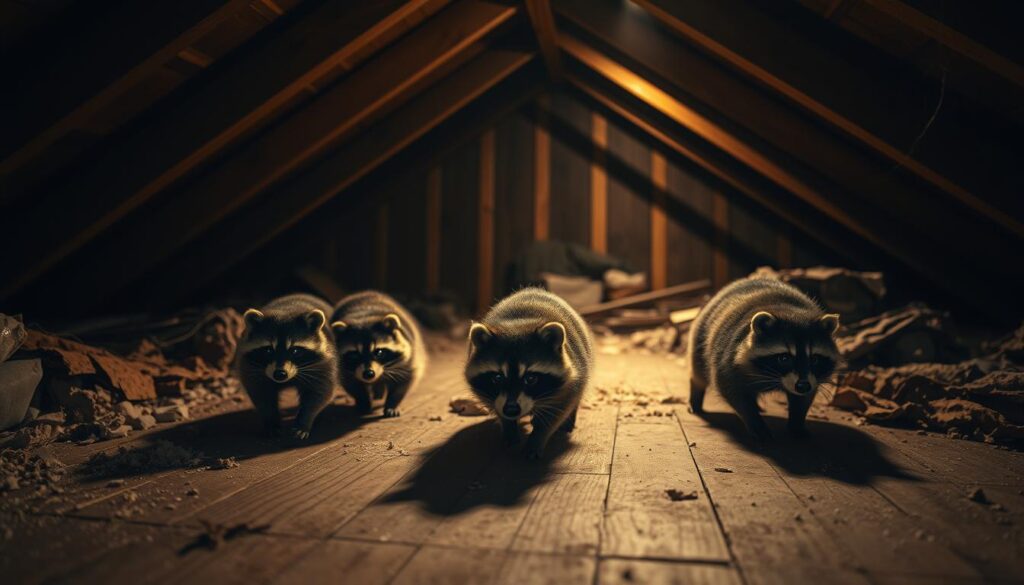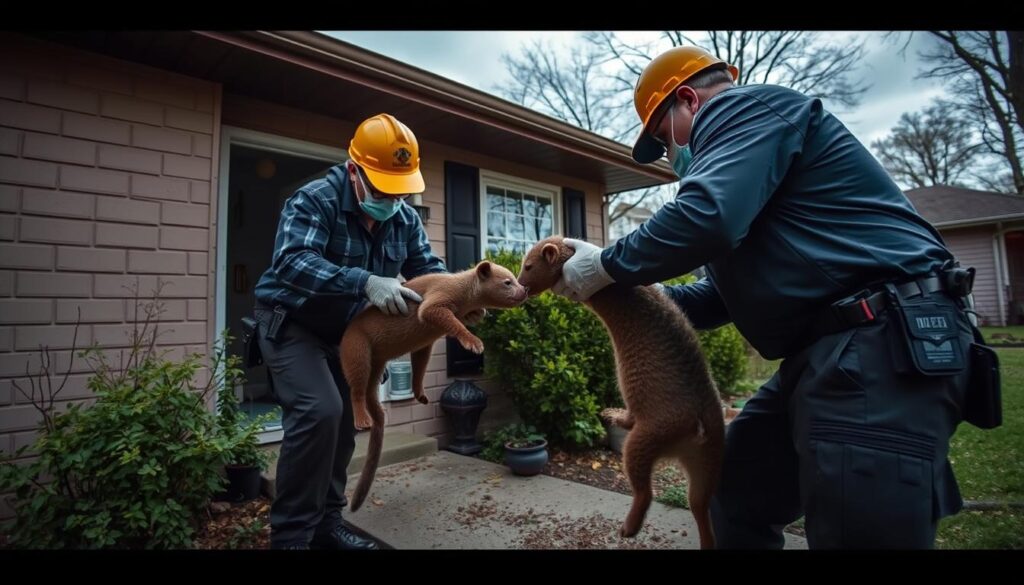Heard Scratching Above? When to Call for Professional Animal Control in Norwalk
Homeowners in Norwalk often deal with wildlife problems. These can cause a lot of damage and health issues. Scratching sounds from above or in walls usually mean there's a bigger problem.
When critters get into homes, it's important to act fast. Wildlife removal experts can solve the problem. They make sure your home is safe and sound. They have the right tools and know-how for these jobs.
Key Takeaways
- Identify signs of wildlife intrusion, such as scratching noises.
- Understand the importance of prompt action in addressing the issue.
- Recognize the role of professionals in wildlife removal and pest control.
- Consider the benefits of hiring local experts familiar with Norwalk CT wildlife.
- Take steps to prevent future intrusions with the help of animal control services.
Wildlife intruders in residential attics are more common than you might think. Many animals look for shelter in attics, causing a lot of disturbance.
Identifying Attic Invaders by Sound and Evidence
To tackle the problem, it's key to figure out who's in your attic. Different animals make different sounds and leave different signs.
Raccoons, Squirrels, and Rodent Identification
- Raccoons are known for their dexterous hands and can make a lot of noise while rummaging through attic storage.
- Squirrels are typically heard scurrying or scratching, often during the day.
- Rodents, such as mice and rats, are usually nocturnal and make faint scratching or scurrying noises.
Seasonal Patterns of Wildlife Intrusions
Wildlife intrusions into attics often follow seasonal patterns.
Why Animals Seek Shelter in Homes
As seasons change, animals seek shelter in homes to escape harsh weather. For example, raccoons and squirrels may invade attics to stay warm during colder months.

Signs That Indicate You Need Professional Animal Control in Norwalk
Homeowners should watch for signs that mean it's time to call animal control in Norwalk. Unwanted wildlife in your home can cause big problems if not fixed fast.
Persistent Scratching, Scurrying, and Other Noises
If you hear scratching, scurrying, or odd noises from your attic or walls, you might have unwanted guests. Sounds like these often mean animals like raccoons, squirrels, or bats have moved in.
Visual Evidence of Animal Presence
Seeing signs can be as telling as hearing noises. Look for droppings, nesting materials, or spotting animals in your home.
Droppings, Nesting Materials, and Entry Points
Animal droppings can be harmful to your health, and nesting materials show a bigger problem. Check your home for holes or gaps that animals might use to get in.
Property Damage and Health Concerns
Wildlife in your home can damage property and pose health risks. Animals can chew on wires, harm insulation, and spread diseases through their droppings.
Disease Risks and Structural Damage
Disease risks are a big worry, as animals can spread diseases to people. Also, damage to your home's structure can lead to expensive fixes.
DIY Solutions vs. Professional Wildlife Removal
Dealing with animals in your attic or yard can be stressful. Choosing between DIY solutions and professional wildlife removal is key. It's important to pick the safest and most effective method.
Limitations of Store-Bought Repellents
Store-bought repellents often don't keep wildlife away for long. They might not work for the specific animal causing trouble. Their success depends a lot on the animal and how bad the problem is.
Risks of Self-Removal Attempts
Trying to remove wildlife yourself can be risky. It can lead to safety hazards and legal problems. Animals may act unpredictably when cornered, causing harm or damage.
Safety Hazards and Legal Considerations
Trying to remove wildlife yourself can expose you to diseases. It may also break local legal considerations about handling animals. Professionals know how to do it safely and legally.

Benefits of Professional Humane Wildlife Management
Professional humane wildlife management services offer a full solution. They ensure wildlife is removed safely and effectively. They also find and seal entry points to stop future problems.
Effective Removal and Prevention Strategies
Professionals use effective removal and prevention strategies. They protect your home from future wildlife invasions. This not only solves the current problem but also gives you long-term peace of mind.
Conclusion: Protecting Your Home from Unwanted Wildlife
Keeping your home safe from wildlife is very important. It helps keep your living space healthy and safe. Knowing the signs of animal intruders and when to get help is key.
At Essential Wildlife Control, we offer humane animal control services in Norwalk. Our team can handle many types of wildlife problems. We make sure your home stays safe from unwanted animals.
If you want to learn more about our services or need a consultation, call us at (203)6675933. Or email us at abrahamewc@gmail.com. We're here to help protect your home from wildlife, giving you peace of mind.
FAQ
Q: What are the most common wildlife intruders in residential attics in Norwalk?
A: In Norwalk, raccoons, squirrels, and rodents are the usual attic invaders. They cause damage and trouble for homeowners.
Q: How can I identify if I have a wildlife intrusion in my attic?
A: Listen for strange noises like scratching and scurrying. Look for animal signs like droppings, nests, or entry points.
Q: What are the risks associated with having wildlife in my attic?
A: Wildlife in your attic can spread diseases and damage your home. It's crucial to deal with it quickly.
Q: Can I remove wildlife from my attic myself?
A: DIY removal is risky and not recommended. It can lead to safety hazards and legal problems. It's better to hire a pro.
Q: How can professional wildlife removal services help me?
A: Services like ours at Essential Wildlife Control can safely remove wildlife. We also prevent future invasions.
Q: What are the benefits of hiring a professional animal control service in Norwalk?
A: Professional services ensure safe and effective wildlife removal. This protects your health, property, and the animals.
Q: How can I contact Essential Wildlife Control for animal control services in Norwalk?
A: Call us at (203)6675933 or email abrahamewc@gmail.com. We'll provide more info and schedule a consultation.